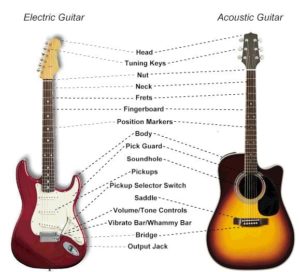
So you’ve decided to become a guitar player. You’ve bought your first guitar, found a teacher, and even paid for the lessons. What now?
Well, you need to know what you’re holding in your hands — you need to understand guitar anatomy.

Knowing the names of different guitar parts will allow you to learn things quicker and talk to other guitarists without worrying about sounding silly. Here’s a quick guitar anatomy lesson for you:
1. The Head
Everything starts with the head. The main purpose of the head is to hold the strings and allow the player to tune the guitar. It holds the tuning pegs, gears, and string ends. Do you know how you feel vibrations in the head area while you’re playing? That’s the instrument’s resonance being transmitted through the head.
2. The Tuning Pegs
As we previously mentioned, you can find the tuning pegs on the head of the guitar. Their main purpose is tuning, which comes as a surprise to nobody. Just a note for beginners: when you’re trying to change a string, make sure to tie its end to the tuning peg. That way, it won’t slip away while you’re trying to put it in place
3. The Neck
The neck is the other major part of the guitar. It’s the longest and thinnest part of the guitar that holds the strings and allows the player to hold the guitar in place while playing. Some people refer to it as the “fretboard” so don’t let that confuse you. Since most guitars are made for right-hand players, the neck is meant to be gripped with the left hand.
4. The Nut
At the point where the neck and head join together, you’ll notice a piece of wood or plastic that’s holding the strings down. This is the nut and it’s there to define where the playable part of the string ends and/or starts.
5. The Frets
You know those lose raised bits all across the neck’s width? Those are called frets and they’re there to help you “shorten” the strings and play different notes and half-notes. Without them, you’ll be forced to guess the length of the note you want to play every time.
6. The Soundhole
An acoustic guitar has a hollow body. The soundhole is that huge, round hole in the body of the guitar, which projects the sound you make by strumming the strings. In essence, the soundhole is a hand-made amplifier, which allows your guitar to sound louder.
7. The Bridge
The bridge is part of the guitar that anchors the strings to the body of the guitar. It transmits the vibration from strings to the body of the guitar, which in turn, creates sound. It’s also one of the most important parts of the guitar when it comes to the action of your guitar.
8. The Body
Finally, we’ve come to the largest part of any guitar: the body. It comes in many shapes and sizes, and depending on the model, it can hold everything from the soundhole, pickups, strings, volume controls, and strap holders. It’s usually made out of high-quality wood. The better the wood, the better the sound. That’s why professional guitars can cost as much as ten times more than standard, beginner-friendly models.
Ready to Operate?
We hope that you enjoyed our article and found it helpful. Did we miss explaining any part? Share your thoughts with us in the comment section below.

